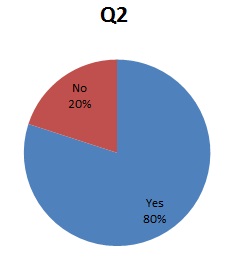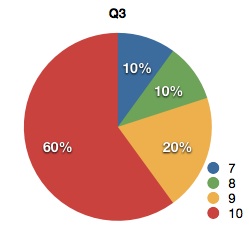Category Archives: Uncategorized
Audience Feedback
After recreating our video we distributed the same questionnaire that we used before to 10 people selected at random from our school. This way we can assess how successful our new video is in comparison to our old video.
The results from the questionnaire were as follows:
 Q1) We asked which genre people thought the film would be based on our opening sequence.Nine out of ten people thought it was a thriller which is great as that was the genre we were establishing. Despite this, one person thought that the film would be an action film. This is a huge improvement from our last video as only 60% of the people we asked thought the film was a thriller, compared to 90% who think our new video is a thriller.
Q1) We asked which genre people thought the film would be based on our opening sequence.Nine out of ten people thought it was a thriller which is great as that was the genre we were establishing. Despite this, one person thought that the film would be an action film. This is a huge improvement from our last video as only 60% of the people we asked thought the film was a thriller, compared to 90% who think our new video is a thriller.
 Q2) We asked whether, based upon our opening sequence, people would want to watch the rest of the film. 80% of people said they would which is much better than the 40% who said they would watch it based on our previous video. 20% of people said they would not want to watch it which is great as with our last video, 60% of people said they would not want to watch the rest of the film. The results have improved greatly since we recreated our video so luckily this was the right decision for us to make. We are pleased that more people want to watch our film now as this means that we have established our opening features correctly and have hooked people in to want to find out what happens next.
Q2) We asked whether, based upon our opening sequence, people would want to watch the rest of the film. 80% of people said they would which is much better than the 40% who said they would watch it based on our previous video. 20% of people said they would not want to watch it which is great as with our last video, 60% of people said they would not want to watch the rest of the film. The results have improved greatly since we recreated our video so luckily this was the right decision for us to make. We are pleased that more people want to watch our film now as this means that we have established our opening features correctly and have hooked people in to want to find out what happens next.

Q3) We asked how well our final video made Jack appear to be a victim on a scale of 1 to 10. 60% of people asked agreed that it was totally clear that Jack was made out to be a victim. 20% of people agreed that we had made him out to be a victim scoring us 9/10, still a great score but room for improvement, which could have been done if we had a longer deadline so had longer to share ideas and film more sequences. 10% of people scored up 8/10 and 10% scored up 7/10. Luckily this was the lowest score we received which still indicates that we made Jack appear victimised well but we could have made this message more clear. However since our last video, these results have improved greatly so we are happy with these scores!
Q4) We asked people what they thought the strengths of our video were. Some answers included:
- “interesting camera angles and techniques”
- “clear story line”
- “appropriate use of music, clear message”
- “a wide range of editing techniques have been used which makes it interesting to watch”
- “it just looks authentic; Jack’s persona, the little girl’s bedroom, it just looks real and as though it could actually happen”
- “the narrative is established and we know what the rest of the film is about”
Q5) We asked people what they thought the weaknesses of our video were. Some answers included:
- “I’m not too keen on the part where Jack is in the girl’s bedroom. I think he would be more angry than this”
- “it’s too dark at the beginning”
- “daughter was misspelled”
- “panic music should come in when he reads the note to emphasise danger”
talking heads
Classification
The BBFC (British Board of Film Classification) was established in 1912. They are fully independent from the government and regulate the UK’s film industry. By censoring content and deciding on what is safe for public viewing, the give films a classification, which is basically an age rating. The ratings consist of:
- U – Universal (suitable for all ages)
- PG – Parental Guidance (suitable for older children with the permission and guidance of parents/carers)
- 12 – Suitable for those over 12 years of age
- 15 – Suitable for those over 15 years of age
- 18 – Suitable for those over 18 years of age
The reason for classifying films by age ratings is to protect children and other vulnerable members of society. Children are very impressionable, especially at a young age, and may copy what they have seen in films and on television. So by denying them access to particular content, they are less likely to act violently as they have not witnessed fictional violent acts. This is known as the copycat theory, and is closely linked to the murder of James Bulger by Jon Venebles and Robert Thompson, two ten year old boys who violently murdered a two year old boy.
An example of their work is after cutting 159 seconds of footage from The Human Centipede 2, to 32 sections of the film, it was released straight onto DVD with a limited cinema run, both with an 18 certificate.
Film Distribution
Planning to Edit
In our coursework task we are planning on editing our clips and using post production to make our video work to its full potential. Almost all media texts use editing in order to sequence individual clips into the right order, add text to a frame or to include non-diagetic sounds whether it be a voice commentary, a sound clip or a piece of music. We will learn and develop editing skills to
- put the clips into the right order whilst ensuring the rules of match on action are not broken – this will ensure that our video flows seamlessly
- add the accompanying music to play alongside the video
- add any other non-diagetic sounds we decide to use e.g. doors closing
- add our names onto the title sequence as producers and editors etc.
In addition to the editing we will also use features of post-production. This may include changing the saturation/contrast of a frame in order to improve its aesthetics and make it more visually stimulating. These techniques can be used to build tension – if a room is dark and contains little colour this subtly indicates the the forthcoming events will also be dark and therefore preparing the audience for impending doom.
With post-production we can also layer different frames or make them flash on top of one another. Really fun effects can be used and all play a role in communicating messages to the audience – e.g. if a frame is blurred or is appearing twice in one frame, faded, this can signify to the audience that a character may be disorientated or confused.
Introduction
AS Media involves planning, designing, creating and evaluating an opening sequence to a film. I will learn and develop the skills needed to create a successful piece of film to ensure the best possible outcome for the video.













